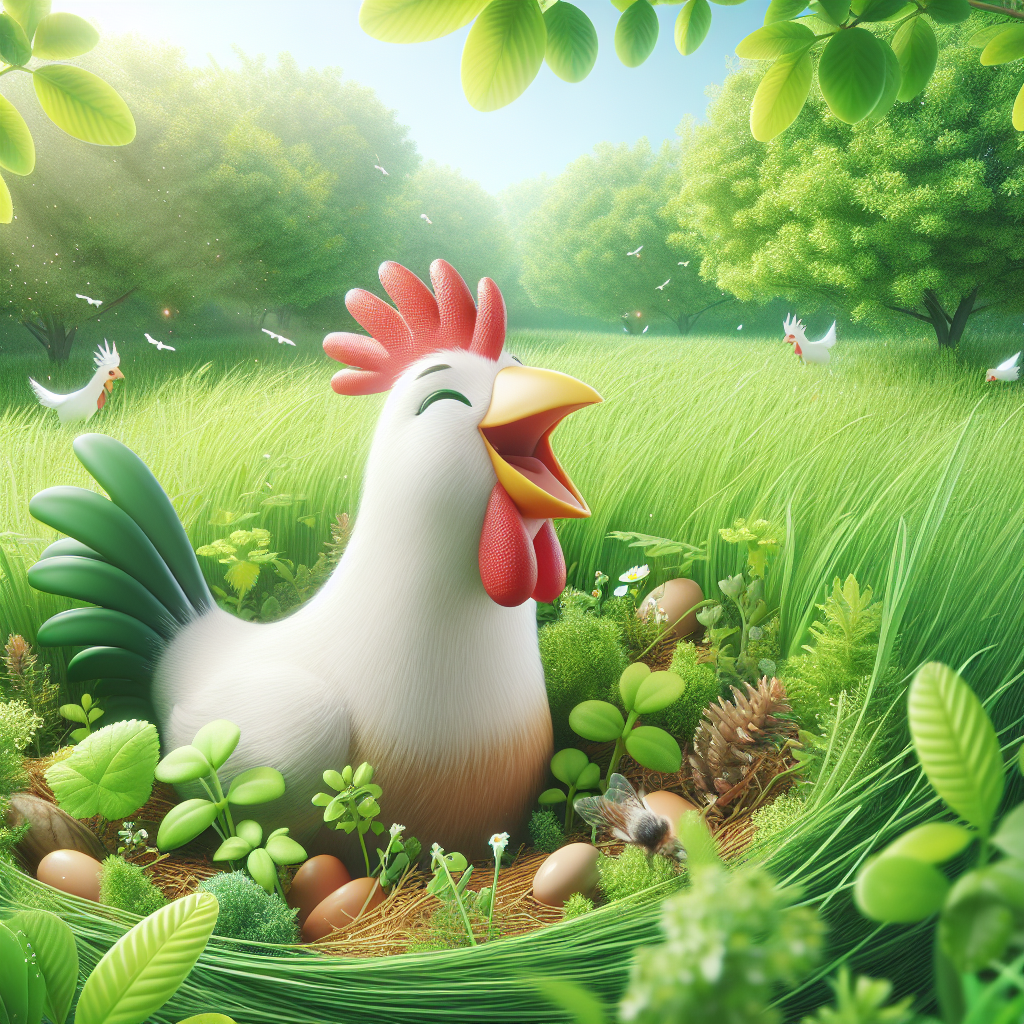Imagine a world where chickens roam freely, pecking at bugs and foraging for food in lush green pastures. Sounds idyllic, right? But have you ever wondered how this free-ranging lifestyle affects the cost of their feed? In this article, we will explore the impact of free-ranging on feed costs and whether it can be a viable cost-saving strategy for farmers. So, prepare to discover how this seemingly simple change in a chicken’s environment can have a significant impact on their diet and the overall economic feasibility of free-ranging.
Definition of Free-ranging
Definition and explanation of free-ranging
Free-ranging refers to a husbandry practice where livestock, such as poultry, pigs, or cattle, are allowed to roam freely and graze on natural forage. This means that they have access to open pastures or other outdoor areas and are not confined to a specific enclosure or restricted to consuming formulated feed. Free-ranging allows animals to exhibit natural behaviors, find their own food sources, and forage for their nutritional needs.
Different types of free-ranging
There are various types of free-ranging systems, each offering different degrees of freedom and access to forage. Some systems involve allowing animals to roam on large, open pastures, giving them ample space to graze and search for natural feed sources. Others may utilize rotational grazing, where animals are moved between multiple smaller pastures over time, allowing the vegetation to regenerate. Additionally, there are systems that provide access to wooded areas or forests, where animals can find a range of forage options.
The Relationship Between Free-ranging and Feed Costs
Free-ranging as a way to reduce feed costs
Free-ranging can be a cost-saving strategy for livestock producers as it reduces the reliance on expensive formulated feed. In free-ranging systems, animals have the opportunity to find their own food sources, such as grass, herbs, insects, and other natural vegetation. This not only reduces the overall feed costs but also provides a more diverse and natural diet for the animals.
Factors influencing feed costs
Feed costs are influenced by various factors, including the availability and price of feed ingredients, labor costs associated with feeding, and the nutritional requirements of the animals. Additionally, the type of livestock and their production stage can also impact feed costs. For example, growing animals typically require higher levels of dietary nutrients, which can increase feed expenses.
Comparative analysis: Free-ranging vs. confined feeding systems
When comparing free-ranging systems to confined feeding systems, there are several factors to consider. While free-ranging systems reduce the need for formulated feed, they may require additional labor and infrastructure for maintaining and managing the grazing areas. Confined feeding systems, on the other hand, may have higher feed costs but can provide more control over nutrient composition and the ability to optimize animal growth and production. Therefore, the choice between the two systems depends on the specific goals, resources, and constraints of the livestock operation.
Feed Availability and Foraging Opportunities in Free-ranging Systems
Access to natural forage
In free-ranging systems, animals have access to a wide range of natural forage sources, including grass, legumes, herbs, and woody plants. This diversity in available forage allows animals to select and consume a variety of nutrients, including essential vitamins and minerals. It also promotes natural browsing and grazing behaviors, which have positive impacts on animal welfare.
Evaluation of available feed sources
Livestock producers must evaluate the quality and suitability of the available feed sources in free-ranging systems. This includes assessing the nutrient composition, digestibility, and potential anti-nutritional factors present in different forage options. Regular monitoring and analysis of forage quality can help ensure that animals are receiving adequate nutrition and optimize feed utilization.
Seasonal variations in feed availability
Feed availability in free-ranging systems can vary throughout the year due to seasonal changes in vegetation growth and availability. In regions with distinct seasons, there may be periods of abundance during spring and summer when lush vegetation is plentiful, while winter months may present challenges in finding sufficient forage. Proactive management, such as stockpiling forage or providing supplemental feed during lean seasons, can help mitigate the impact of seasonal variations.
Potential impact on nutritional requirements
The nutritional requirements of animals in free-ranging systems may differ from those in confined feeding systems due to the diverse forage options available. Livestock producers must assess the nutrient composition of the forage and ensure it meets the specific needs of the animals, taking into account factors like age, production stage, and the desired performance outcomes. Regular monitoring and adjustments in feed supplementation may be necessary to meet nutritional requirements and maintain optimal animal health.
Feed Utilization and Efficiency in Free-ranging Systems
Effectiveness of utilization of available feed
The ability of livestock to effectively utilize available feed resources in free-ranging systems depends on factors such as forage quality, animal species, and individual animal characteristics. Animals that have adapted to grazing behaviors can efficiently extract nutrients from forage sources, such as grass, while minimizing feed wastage. However, factors such as competition for feed, variations in animal grazing behavior, and digestibility of certain forage types may influence the overall efficiency of feed utilization.
Foraging behavior and efficiency
Foraging behavior plays a crucial role in the efficiency of feed utilization in free-ranging systems. Animals that exhibit active and efficient foraging behaviors are likely to locate and consume a greater proportion of available forage compared to those that display less exploratory behaviors. Producers can encourage positive foraging behaviors by ensuring a diverse range of forage options, minimizing competition for feed, and providing appropriate grazing management strategies.
Risk of overconsumption and wasted feed
In free-ranging systems, there is a potential risk of animals overconsuming certain forage sources, particularly if high-quality options are abundant. This can lead to imbalances in the animal’s diet, excess nutrient intake, and wastage of feed resources. Effective grazing management practices, including rotational grazing, can help prevent overconsumption and ensure optimal feed utilization while minimizing feed wastage.
Adaptability of different livestock species
Different livestock species have varying degrees of adaptability to free-ranging systems. Some species, such as goats and poultry, are highly adapted to foraging behaviors and have the ability to utilize a wide range of natural feed sources effectively. Others, like certain breeds of cattle, may be less efficient at utilizing certain types of forage. Livestock producers should consider the adaptability and compatibility of different species or breeds with the specific free-ranging system being implemented.
Quality and Composition of Feed in Free-ranging Systems
Nutritional value of natural forage
Natural forage in free-ranging systems can vary in its nutritional value, depending on factors such as soil fertility, plant species composition, and maturity stage. It is essential to assess the nutrient content, including proteins, fibers, vitamins, and minerals, in the forage to ensure that animals receive a balanced and adequate diet. Regular forage sampling and analysis can help identify any nutrient deficiencies or excesses and guide appropriate supplementation strategies.
Variability in feed quality
The quality of feed in free-ranging systems can vary due to factors such as seasonal changes, variations in plant species composition, and environmental conditions. Forage quality can be influenced by factors like rainfall, temperature, soil fertility, and management practices. While this natural variability can provide a diverse diet for animals, it also necessitates regular monitoring and adjustments in feed supplementation to maintain a consistent nutritional profile.
Supplementation requirements
In free-ranging systems, where the forage alone may not provide all the necessary nutrients, supplementation becomes essential to meet the animal’s nutritional requirements effectively. Supplemental feed can include concentrated feeds, minerals, vitamins, or other specific additives needed for optimal animal health and performance. The type and amount of supplementation required will depend on the specific forage quality, animal species, and production goals.
Evaluation of feed composition
Livestock producers should evaluate the composition of feed in free-ranging systems to ensure a balanced and suitable diet for the animals. This includes assessing the levels of proteins, carbohydrates, fats, vitamins, minerals, and other essential nutrients. Regular analysis of feed composition can help monitor changes in forage quality, identify any nutrient deficiencies or imbalances, and make appropriate adjustments in the animal’s diet to maintain health and productivity.
Health and Welfare Considerations in Free-ranging Systems
Disease prevention and management
While free-ranging systems can promote natural behaviors and reduce stress, there are still health considerations to be addressed. Animal diseases and parasite infections can occur in free-ranging systems, necessitating effective disease prevention and management strategies. This may include vaccination programs, regular veterinary care, biosecurity measures, and appropriate quarantine procedures. Regular monitoring and proactive disease prevention can help maintain animal health and welfare in free-ranging systems.
Parasite control and impact on feed costs
Parasite infections, such as internal and external parasites, can impact the health and productivity of animals in free-ranging systems. Effective parasite control measures, such as strategic deworming programs and pasture management practices, must be implemented to minimize the economic and health impacts. While these control measures may incur additional costs, they are essential to ensure optimal feed utilization and prevent significant losses due to parasite-related issues.
Behavioral and psychological benefits
Free-ranging systems can provide behavioral and psychological benefits to animals by allowing them to exhibit natural behaviors, such as grazing, rooting, or pecking. These systems promote higher levels of physical activity, mental stimulation, and social interactions, which can contribute to enhanced animal welfare. The ability to engage in natural behaviors can reduce stress, improve overall health, and positively impact the animals’ well-being.
Risk of injury and predation
While free-ranging systems offer increased freedom and natural behaviors, there are inherent risks associated with exposure to the outdoor environment. Animals may be susceptible to injuries from rough terrains, interactions with other livestock or wildlife, or accidents caused by equipment or structures. Additionally, predation by predators, such as wolves or coyotes, can pose a threat to free-ranging animals. Adequate fencing, shelter, and regular monitoring can help mitigate these risks and ensure the safety and welfare of the animals.
Economic Analysis of Free-ranging Systems
Cost-benefit analysis
When considering the economic viability of free-ranging systems, it is essential to conduct a cost-benefit analysis. This involves evaluating both the costs and potential benefits associated with implementing and managing a free-ranging operation. Factors such as labor costs, initial infrastructure investments, ongoing maintenance, and potential savings from reduced feed costs must be considered to determine the financial feasibility of free-ranging systems.
Long-term profitability
Long-term profitability is an important consideration for livestock producers. While free-ranging systems may offer cost-saving opportunities, it is crucial to assess the overall financial sustainability of the operation. Factors such as market demand, livestock productivity, infrastructure investments, and ongoing management costs must be evaluated to ensure continued profitability over the long term.
Factors affecting economic feasibility
The economic feasibility of free-ranging systems can be influenced by various factors. These factors include local feed prices, land availability and costs, market prices for free-ranging products, labor availability, regulatory requirements, and management efficiency. Each of these factors must be considered to determine whether free-ranging is a viable and financially sound option for a specific livestock operation.
Market demand and consumer preferences
Consumer preferences and market demand play a significant role in the economic feasibility of free-ranging systems. Increasingly, consumers are showing a preference for products that are perceived as more natural, sustainable, and ethically produced. This can create opportunities for producers operating in free-ranging systems, as they align with consumer demands for high-quality, welfare-friendly products. Market research and understanding consumer trends can help identify potential market niches and maximize the economic potential of free-ranging systems.
Environmental Impacts of Free-ranging Systems
Sustainable land use practices
Free-ranging systems can contribute to sustainable land use practices by utilizing pasture and forage resources efficiently. Proper grazing management, including rotational grazing and rest periods for the land, can help prevent overgrazing and promote healthy vegetation growth. By optimizing land use, free-ranging systems can minimize soil erosion, conserve biodiversity, and maintain the ecological balance of the surrounding environment.
Ecological benefits and conservation
Free-ranging systems can provide ecological benefits by promoting biodiversity and natural ecosystems. When animals have the opportunity to graze and forage in open pastures or wooded areas, they contribute to vegetation management and seed dispersal. This can help maintain diverse plant communities and support the habitat of various wildlife species. Properly managed free-ranging systems can contribute to conservation efforts and preserve local ecosystems.
Potential environmental drawbacks
While free-ranging systems have ecological benefits, they can also present potential environmental drawbacks. Animals grazing freely may have access to sensitive areas such as water bodies or fragile landscapes, leading to nutrient runoff or habitat destruction. Overgrazing can adversely impact plant diversity and soil health. It is vital for livestock producers to implement appropriate management practices that mitigate these environmental risks and minimize negative impacts.
Mitigation strategies
To mitigate the potential environmental impacts of free-ranging systems, several strategies can be implemented. These may include strategic fencing to control animal access to sensitive areas, proper manure management to prevent nutrient runoff, and rotational grazing to promote vegetation regeneration. Additionally, working with agricultural extension services and implementing best management practices can help minimize adverse environmental impacts and maximize the sustainability of free-ranging systems.
Regulatory Considerations for Free-ranging Systems
Government policies and regulations
Free-ranging systems are subject to government policies and regulations that may vary between jurisdictions. These regulations often aim to ensure animal welfare, food safety, environmental protection, and traceability. Livestock producers must be familiar with and comply with these regulations, which may include requirements for grazing management, vaccination programs, record-keeping, and farm inspections.
Permits and licensing requirements
Depending on the scale and nature of the free-ranging operation, livestock producers may need to obtain permits and licenses from government agencies. These permits can cover aspects such as land use, water usage, animal movement, or processing and marketing of free-ranging products. Compliance with the necessary permits and licensing requirements is essential to ensure legal operation and demonstrate adherence to regulatory standards.
Compliance with welfare standards
Animal welfare is a paramount consideration in free-ranging systems, and adherence to welfare standards is often required by regulations. Producers must ensure that animals have access to adequate shelter, clean water, appropriate nutrition, and protection from adverse weather conditions. Additionally, minimizing stress, preventing injury, and providing veterinary care are important aspects of welfare management in free-ranging systems.
Food safety and traceability
Free-ranging systems must adhere to food safety regulations to ensure the production of safe and high-quality products. This includes practices such as maintaining proper sanitation, implementing biosecurity measures, and following appropriate handling and processing protocols. Traceability, from farm to fork, is also crucial in free-ranging systems to identify and track the origin and history of the products, which contributes to consumer confidence and ensures accountability throughout the supply chain.
Case Studies: Success and Challenges of Free-ranging Systems
Examining successful free-ranging operations
Case studies of successful free-ranging systems can provide valuable insights into the factors that contribute to their success. These case studies may focus on various livestock species and highlight innovative management practices, grazing strategies, and marketing approaches that have proven effective. By analyzing these success stories, livestock producers can learn from the experiences of others and apply best practices to their own operations.
Identifying common challenges and obstacles
Alongside success stories, it is crucial to identify and address the common challenges and obstacles faced by free-ranging systems. These challenges may include issues such as finding suitable grazing land, managing predators, controlling parasites, or complying with regulatory requirements. Understanding these challenges and developing practical solutions can help overcome obstacles and improve the overall viability of free-ranging systems.
Lessons learned and strategies for success
From both successes and challenges, free-ranging systems offer valuable lessons for livestock producers aiming to implement or improve their operations. These lessons may involve optimizing grazing management, improving feed utilization and supplementation, addressing animal health and welfare considerations, or enhancing marketing strategies. By learning from the experiences of others, livestock producers can refine their practices and increase their chances of success in free-ranging systems.
In conclusion, free-ranging systems can have a significant impact on feed costs and are a viable cost-saving strategy for livestock producers. By allowing animals to access natural forage, free-ranging reduces the reliance on expensive formulated feed and provides a more diverse and natural diet for the animals. While various factors such as feed availability, utilization efficiency, and health considerations must be carefully managed, the economic, environmental, and welfare benefits of well-managed free-ranging systems make them an attractive option for many livestock operations. Through comprehensive analysis, adaptive management, and compliance with regulations, livestock producers can successfully implement and maintain free-ranging systems that optimize feed costs while promoting optimal animal health, welfare, and sustainable production.




